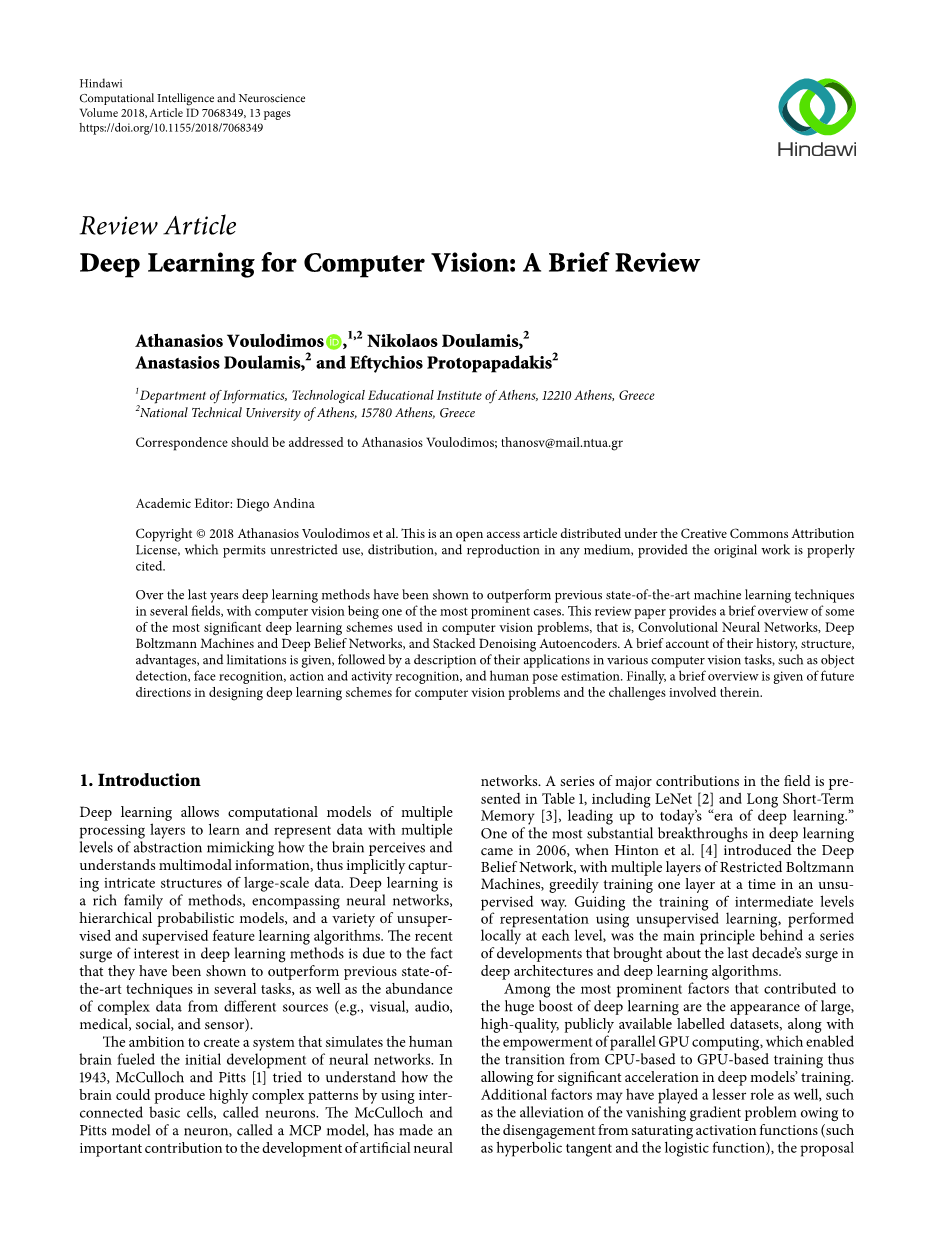英语原文共 14 页,剩余内容已隐藏,支付完成后下载完整资料
原文:
Deep Learning for Computer Vision: A Brief Review
Abstract
With the overwhelming amount of complex and heterogeneous data pouring from any-where, any-time, and any-device, there is undeniably an era of Big Data. The emergence of the Big Data as a disruptive technology for next generation of intelligent systems, has brought many issues of how to extract and make use of the knowledge obtained from the data within short times, limited budget and under high rates of data generation. Companies are recognizing that big data can be used to make more accurate predictions, and can be used to enhance the business with the help of appropriate association rule mining algorithm. To help these organizations, with which software and algorithm is more appropriate for them depending on their dataset, we compared the most famous three MapReduce based software Hadoop, Spark, Flink on two widely used algorithms Apriori and Fp-Growth on different scales of dataset.
Over the last years deep learning methods have been shown to outperform previous state-of-the-art machine learning techniques in several felds, with computer vision being one of the most prominent cases. Tis review paper provides a brief overview of some of the most signifcant deep learning schemes used in computer vision problems, that is, Convolutional Neural Networks, Deep Boltzmann Machines and Deep Belief Networks, and Stacked Denoising Autoencoders. A brief account of their history, structure, advantages, and limitations is given, followed by a description of their applications in various computer vision tasks, such as object detection, face recognition, action and activity recognition, and human pose estimation. Finally, a brief overview is given of future directions in designing deep learning schemes for computer vision problems and the challenges involved therein.
Keyword:Computer Vision; Distributed, Parallel, and Cluster Computing (cs.DC)
- Introduction
Deep learning allows computational models of multiple processing layers to learn and represent data with multiple levels of abstraction mimicking how the brain perceives and understands multimodal information, thus implicitly capturing intricate structures of large-scale data. Deep learning is a rich family of methods, encompassing neural networks, hierarchical probabilistic models, and a variety of unsupervised and supervised feature learning algorithms. Te recent surge of interest in deep learning methods is due to the fact that they have been shown to outperform previous state-ofthe-art techniques in several tasks, as well as the abundance of complex data from diferent sources (e.g., visual, audio, medical, social, and sensor)
Te ambition to create a system that simulates the human brain fueled the initial development of neural networks. In 1943, McCulloch and Pitts [1] tried to understand how the brain could produce highly complex patterns by using interconnected basic cells, called neurons. Te McCulloch and Pitts model of a neuron, called a MCP model, has made an important contribution to the development of artifcial neural networks. A series of major contributions in the feld is presented in Table 1, including LeNet [2] and Long Short-Term Memory [3], leading up to todayrsquo;s “era of deep learning.” One of the most substantial breakthroughs in deep learning came in 2006, when Hinton et al. [4] introduced the Deep Belief Network, with multiple layers of Restricted Boltzmann Machines, greedily training one layer at a time in an unsupervised way. Guiding the training of intermediate levels of representation using unsupervised learning, performed locally at each level, was the main principle behind a series of developments that brought about the last decadersquo;s surge in deep architectures anddeep learning algorithms.
Among the most prominent factors that contributed to the huge boost of deep learning are the appearance of large, high-quality, publicly available labelled datasets, along with the empowerment of parallel GPU computing, which enabled the transition from CPU-based to GPU-based training thus allowing for signifcant acceleration in deep modelsrsquo; training. Additional factors may have played a lesser role as well, such as the alleviation of the vanishing gradient problem owing to the disengagement from saturating activation functions (such as hyperbolic tangent and the logistic function), the proposal of new regularization techniques (e.g., dropout, batch normalization, and data augmentation), and the appearance of powerful frameworks like TensorFlow [5], theano [6], and mxnet [7], which allow for faster prototyping.Deep learning has fueled great strides in a variety of computer vision problems, such as object detection (e.g.,[8, 9]), motion tracking (e.g., [10, 11]), action recognition (e.g.,[12, 13]), human pose estimation (e.g., [14, 15]), and semanticsegmentation (e.g., [16, 17]). In this overview, we will concisely review the main developments in deep learning architectures and algorithms for computer vision applications. Inthis context, we will focus on three of the most important types of deep learning models with respect to their applicability in visual understanding, that is, Convolutional NeuralNetworks (CNNs), the “Boltzmann family” including Deep Belief Networks (DBNs) and Deep Boltzmann Machines (DBMs) and Stacked (Denoising) Autoencoders. Needless to say, the current coverage is by no means exhaustive; for example, Long Short-Term Memory (LSTM), in the category of Recurrent Neural Networks, although of gr
剩余内容已隐藏,支付完成后下载完整资料
资料编号:[259585],资料为PDF文档或Word文档,PDF文档可免费转换为Word
以上是毕业论文外文翻译,课题毕业论文、任务书、文献综述、开题报告、程序设计、图纸设计等资料可联系客服协助查找。




